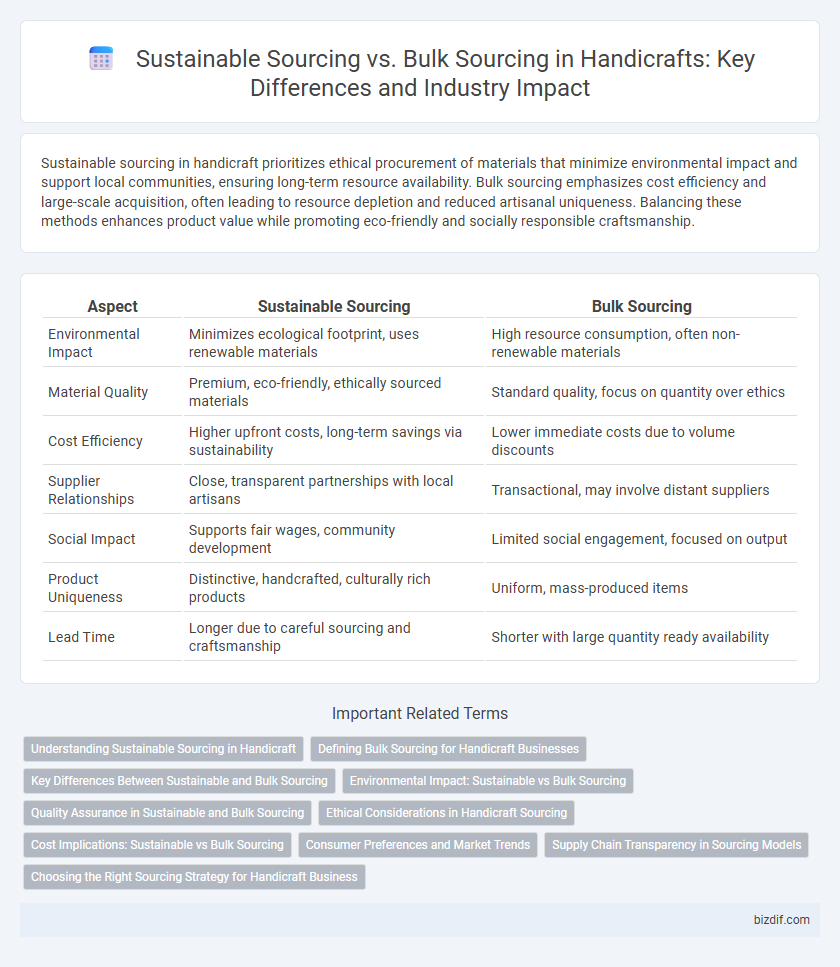Sustainable sourcing in handicraft prioritizes ethical procurement of materials that minimize environmental impact and support local communities, ensuring long-term resource availability. Bulk sourcing emphasizes cost efficiency and large-scale acquisition, often leading to resource depletion and reduced artisanal uniqueness. Balancing these methods enhances product value while promoting eco-friendly and socially responsible craftsmanship.
Table of Comparison
| Aspect | Sustainable Sourcing | Bulk Sourcing |
|---|---|---|
| Environmental Impact | Minimizes ecological footprint, uses renewable materials | High resource consumption, often non-renewable materials |
| Material Quality | Premium, eco-friendly, ethically sourced materials | Standard quality, focus on quantity over ethics |
| Cost Efficiency | Higher upfront costs, long-term savings via sustainability | Lower immediate costs due to volume discounts |
| Supplier Relationships | Close, transparent partnerships with local artisans | Transactional, may involve distant suppliers |
| Social Impact | Supports fair wages, community development | Limited social engagement, focused on output |
| Product Uniqueness | Distinctive, handcrafted, culturally rich products | Uniform, mass-produced items |
| Lead Time | Longer due to careful sourcing and craftsmanship | Shorter with large quantity ready availability |
Understanding Sustainable Sourcing in Handicraft
Sustainable sourcing in handicraft emphasizes the use of environmentally friendly, ethically sourced materials that support local artisans and reduce ecological impact. This approach prioritizes natural fibers, recycled components, and fair trade practices to ensure long-term resource preservation and community empowerment. By contrast, bulk sourcing often overlooks these factors, favoring volume and cost-efficiency over sustainability and artisan welfare.
Defining Bulk Sourcing for Handicraft Businesses
Bulk sourcing in handicraft businesses involves acquiring large quantities of raw materials or components at once, typically to reduce costs and streamline production processes. This approach prioritizes volume discounts and supply consistency but can lead to less flexibility and higher environmental impact compared to sustainable sourcing practices. Handicraft businesses relying on bulk sourcing often face challenges in maintaining product uniqueness and ethical standards while meeting high demand.
Key Differences Between Sustainable and Bulk Sourcing
Sustainable sourcing in handicrafts prioritizes ethical practices, environmental responsibility, and fair wages, ensuring raw materials come from renewable or recycled sources. Bulk sourcing focuses on acquiring large quantities of materials at the lowest possible cost, often compromising on quality and ethical standards. Key differences include the impact on local communities, long-term resource management, and the overall environmental footprint of the supply chain.
Environmental Impact: Sustainable vs Bulk Sourcing
Sustainable sourcing in handicrafts prioritizes eco-friendly materials and ethical labor, significantly reducing carbon footprints and waste compared to bulk sourcing. Bulk sourcing often relies on mass production techniques that deplete natural resources and increase pollution through excessive energy use and packaging. Choosing sustainable sourcing fosters biodiversity preservation and supports circular economy principles within the handicraft industry.
Quality Assurance in Sustainable and Bulk Sourcing
Sustainable sourcing emphasizes ethical procurement practices and environmental responsibility, ensuring high-quality handicraft materials through certified suppliers and traceability. Bulk sourcing prioritizes cost efficiency and volume, which may compromise material quality and consistency without rigorous quality control measures. Implementing stringent quality assurance protocols in both sourcing methods is essential to maintain product integrity and customer satisfaction.
Ethical Considerations in Handicraft Sourcing
Sustainable sourcing in handicrafts prioritizes ethical considerations by ensuring fair wages, safe working conditions, and environmentally friendly materials, which supports artisan communities and preserves cultural heritage. Bulk sourcing often prioritizes cost reduction and volume, risking exploitation of labor and depletion of natural resources in handicraft production. Ethical handicraft sourcing aligns with sustainable practices, promoting social responsibility and long-term ecological balance.
Cost Implications: Sustainable vs Bulk Sourcing
Sustainable sourcing in handicraft involves higher upfront costs due to ethical material procurement, fair labor wages, and eco-friendly processes, impacting the overall production budget. Bulk sourcing lowers expenses by purchasing large volumes from conventional suppliers, benefiting from economies of scale but often compromising environmental and social responsibility. Long-term savings in sustainable sourcing arise from brand loyalty, market differentiation, and reduced environmental impact, offsetting initial cost differences compared to bulk sourcing.
Consumer Preferences and Market Trends
Sustainable sourcing in handicrafts aligns with growing consumer demand for ethically produced, eco-friendly products, fostering brand loyalty and supporting fair trade artisans. In contrast, bulk sourcing prioritizes cost-efficiency and mass production, often compromising environmental and social standards. Market trends indicate a significant shift toward sustainable sourcing as buyers increasingly value transparency, authenticity, and the positive social impact of their purchases.
Supply Chain Transparency in Sourcing Models
Sustainable sourcing in handicraft emphasizes supply chain transparency by ensuring ethical material origins and fair labor practices, fostering trust and environmental responsibility. Bulk sourcing often involves opaque supply chains, leading to potential challenges in verifying ethical standards and contributing to environmental degradation. Transparent sustainable sourcing models enable artisans and consumers to make informed decisions, promoting long-term social and ecological benefits.
Choosing the Right Sourcing Strategy for Handicraft Business
Sustainable sourcing in handicraft prioritizes ethically obtained materials and supports local artisans, enhancing brand value and customer loyalty in an eco-conscious market. Bulk sourcing reduces costs through large-volume purchases but may compromise quality and authenticity, risking the unique appeal of handmade products. Choosing the right sourcing strategy depends on balancing cost efficiency with commitment to craftsmanship, cultural preservation, and environmental impact.
Sustainable Sourcing vs Bulk Sourcing Infographic

 bizdif.com
bizdif.com